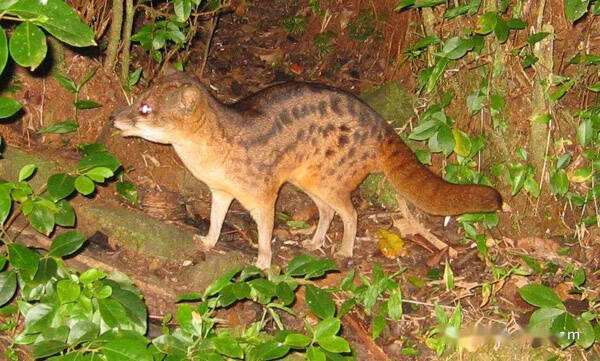Fossa fossana
IUCN
LCBasic Information
Scientific classification
- name:Fossa fossana
- Scientific Name:Fossa fossana,Spotted Fanaloka,Malagasy civet, Malagasy civet, Malagasy civet
- Outline:Carnivora
- Family:Schizopoda Viverridae Myrmecophaga Myrmecophaga
Vital signs
- length:61-70cm
- Weight:1.5-2kg
- lifetime:No verification information
Feature
Looks and acts like a fox
Distribution and Habitat
Distributed in most areas of Madagascar, it mainly lives in the northeast of Madagascar and also exists in the deciduous forests of the Ankarana Mountains in the north of the island.
The living environment ranges from lowland humid rainforests to dry high altitude areas. It mainly inhabits tropical rainforests below 2,700 meters above sea level, subtropical mountain wet evergreen broad-leaved forests, monsoon evergreen broad-leaved forests and their forest edge shrubs, tall grass and other habitats.
Appearance
The Falkland Island civet cat is a small mammal. It is 61-70 cm in total length, with a trunk length of 40-45 cm and a tail length of 21-25 cm; it weighs 1.5-2 kg. They look and act like foxes. They have a slender body, a narrow face and a protruding snout. They have fluffy fur, short and dense light brown hair all over their body, and the top of their head and back are brownish yellow with gray. There are four black vertical stripes and many black stripes along the sides of their body from the head to the tail. These stripes turn into spots near the abdomen. There are no spots on the lower body, which is usually light cream or white. Their feet are very short, with 5 toes on each front and rear limbs, and their claws are semi-retractable. There are 2 pairs of molars in the upper and lower jaws, and the upper molars are arranged horizontally.
Details
The Spotted Fanaloka (scientific name: Fossa fossana) is also called the Spotted Fanaloka, but it is not a cat. It is called the Spotted Fanaloka because some of its characteristics are similar to those of cats after it evolved to adapt to the jungle living environment. In the past, it was classified together with the banded civet cat in the subfamily of the Catinae, and then classified into the independent subfamily of the Catinae, but now it has been changed to the subfamily of the Anteater. It belongs to the genus Fossa.

The Malvinas live in pairs, often occupying a territory of about one square mile, using glands near the neck and anus to secrete scent to mark the boundaries. It is a nocturnal animal, sleeping in hollow trees or rock crevices during the day. It becomes active only at dusk. It is good at climbing trees. It is extremely ferocious. When threatened, it often bares its teeth and roars. Vocals include a range of cries and groans, as well as the characteristic "coq-coq", which is only uttered when more than one individual is present.
The Maldivian civet forages in forest trees and on the ground, mainly insects similar to locusts, rodents, birds, amphibians, reptiles and invertebrates. Fruits and crabs are occasionally eaten. When food sources are scarce, their fat stores calories, especially in the tail, in preparation for wintering (June to August).
Males and females form pairs during the breeding season, sharing and defending a large territory, marking its boundaries with scent produced by glands around the anus and cheeks. The mating season is in August-September. After three months of pregnancy, a cub with open eyes and covered with fur is produced. They can walk at three days old. The subsequent development is relatively slow. They can eat meat at one month old, are fully weaned at 2-3 months old, and are independent at one year old.
The distribution of the Malagasy civet is decreasing. The main threat is habitat destruction. They are threatened by large-scale deforestation in Madagascar. Since humans arrived in Madagascar 1500 to 2000 years ago, about 80% of the original tree cover has been destroyed. The local original forest is being replaced by cultivated crops. Another threat facing the species includes being trapped as food and competition with the introduced small civet (Viverricula indica).
Listed in the 2015 IUCN Red List of Threatened Species ver 3.1 - Vulnerable (VU).
Protect wild animals and eliminate game.
Maintaining ecological balance is everyone's responsibility!








